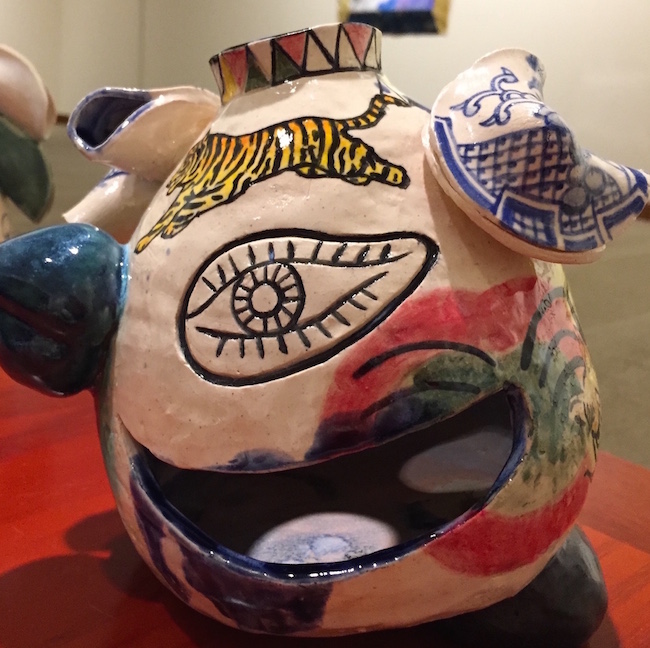SALINA, KANSAS — Maybe it’s a side-effect of what I do for a living, but I’m becoming fond of loaded images and cultural signifiers that seem to have lost their meaning. I’ve been geeking out on Biblical criticism lately and found a weird one. Apparently scholars have been spilling a lot of ink over a story in the book of Mark in which a young man is seized by soldiers and gets away by stripping off his robe. The soldiers are left holding the robe and the young man runs off into the night, naked. What is the point of this story? No one knows. A guess is that it once stood for an aphorism that people would have understood back in the day. That meaning didn’t survive and now we’re left with a story that seems significant, but communicates nothing.
Above image: Jiha Moon, Mexican Korea Blue Willow Face Jug, 2014. Photograph by Janet Tyson.

Installation view of fiber works at Jiha Moon, “Double Welcome: Most Everyone’s Mad Here” at the Kalamazoo Institute of Arts. Photograph by Janet Tyson. Click to see a larger image.
Signifiers aren’t meaning. They’re artifacts of how we communicate. We have an accepted method of processing these signs and that happens so quickly we often don’t think of the signs themselves. These signs can break down. They can change their significance in concert with other signs. Certain meanings don’t communicate well across cultures. The signs can be entirely stripped of meaning, leading us back to good ol’ chaos, white noise.
So maybe that’s why Korean-born, Atlanta-based artist Jiha Moon chose to title her exhibit after a line in Alice in Wonderland (the go-to book for chaos-loving weirdos and kids on drugs). Double Welcome: Most Everyone’s Mad Here is a traveling exhibition that piles a bunch of these signifiers together and lets them shout at each other across 50 works of contemporary ceramic art, fiber, and paper. The show rises again at the Salina Art Center from April 6 – June 12.


Jiha Moon, Small Peach, 2013. Photograph by Janet Tyson.
Signifiers from Eastern and Western cultures, gods, pop culture icons, emojis from your smartphone and characters from the Angry Birds videogame all compete for your attention in this show. The curators of the Halsey Institute of Contemporary Art see it as kind of uber-identity that rises from a swamp of cultural signifiers brought together by a world that’s more networked than ever before.
Moon’s witty and ironic work explores how Westerners perceive other cultures and how perceived foreigners see the West. Korean born, now living in the United States, Moon asks the pertinent question, “Why do people love foreign stuff so much? When we travel to other countries, explore different cultures, and meet with new people, we tend to fall in love with things that are not our own. People have a soft spot for foreign things. The world is so interconnected nowadays, how can you even tell where someone or something ‘comes from’ anymore?” In her work, Moon acts in the role of a traveler, and explores the notion that identity is not beholden to geographic location.


Janet Tyson, writing for Hyperallergic, was down on the show, saying that nothing she saw there engaged her. “Too much, too loud,” appears to be the criticism.
“Such lack of enthusiasm on my part was a real revelation about personal taste, and its bearing upon critical opinion. I realized that I prefer work that leaves room for reflection — rather than pulling me into polemics or, in Moon’s case, a surfeit of celebration. From the get-go, my prejudices were in play and nothing on view budged them. If I can articulate this struggle at all clearly, it would be to say that Moon does not sufficiently differentiate her pop culture “mélange” from the raucous visuals that are featured on the woven plastic tote bags at my local hipster shop.”

Strange that she would use “hipster” as a criticism in light of the show. Few words have seen as much abuse. When I last checked, a “hipster” was anyone who goes out in public wearing anything other than the uniform for their shift at Quiznos. I’m a hipster. My friends are all hipsters. My wife’s a hipster. Your mom’s a hipster. If you’re reading this site, there’s a 99.999 percent chance that you’ve been called a hipster, too. I’m not pointing this out to criticize Janet’s writing (though can we please agree to bury the word “hipster” in an unmarked grave?), but rather to make a point: Hipster signifies so much that it’s a broken word. It meant something at one point and then it metastasized, growing freakishly bloated like some monster in a Cronenberg movie. It collapsed under its own weight and is now a black hole, devouring meaning instead of giving meaning.
As I look at the piles of signifiers on parade in Moon’s exhibition, all of them fighting for scarce real estate, I wonder where that breaking point is. At what point will the emojis overwhelm agreed-upon meaning and start to devour the universe like a self-replicating gray goo? When will the symbols turn on their masters? One day we’ll be sitting with our noses pressed to our cell phones and the chaos singularity will happen. We’ll send texts but communicate nothing, left with only the phantom limb sensation that has taken the place of meaning.
Add this to my list of favorite apocalypse scenarios.
Bill Rodgers is the Managing Editor of cfile.daily.
Do you love or loathe these works of contemporary ceramic art? Let us know in the comments.


Why do Moon’s broken vessels signify?